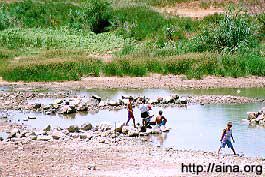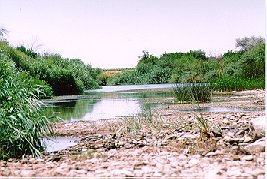

 (AINA) -- The current three year long drought to hit Syria and the surrounding region has had an especially disastrous impact on the Assyrian population in the northeastern part of the country. Whereas the primarily agrarian Assyrian community along the Khabur river previously thrived on fertile irrigated lands, the last three years have yielded little or no harvest. Escalating hardship to the whole agriculture-based regional economy is leading many Assyrians to consider abandoning their lands.
(AINA) -- The current three year long drought to hit Syria and the surrounding region has had an especially disastrous impact on the Assyrian population in the northeastern part of the country. Whereas the primarily agrarian Assyrian community along the Khabur river previously thrived on fertile irrigated lands, the last three years have yielded little or no harvest. Escalating hardship to the whole agriculture-based regional economy is leading many Assyrians to consider abandoning their lands.
 Over the past decade, with steadily dwindling rainfall, increasing numbers of illegal wells have been dug in the Ras Al-Ain area by non-Assyrians for crop irrigation. At times, Ras Al-Ain has completely dried up leaving the once mighty Khabur River with nothing more than isolated mud puddles. It is believed that nearly two thousand illegal wells have been dug in the environs of Ras Al-Ain south of the Turkish border and just north of the thirty-five Assyrian villages. Some wells have also been reportedly dug within Turkey north of Ras Al-Ain, further tapping into the underground water table that forms the lifeline of the region.
Over the past decade, with steadily dwindling rainfall, increasing numbers of illegal wells have been dug in the Ras Al-Ain area by non-Assyrians for crop irrigation. At times, Ras Al-Ain has completely dried up leaving the once mighty Khabur River with nothing more than isolated mud puddles. It is believed that nearly two thousand illegal wells have been dug in the environs of Ras Al-Ain south of the Turkish border and just north of the thirty-five Assyrian villages. Some wells have also been reportedly dug within Turkey north of Ras Al-Ain, further tapping into the underground water table that forms the lifeline of the region.
"Disturbing reports disclosed that
Syria announced an agreement to provide
neighboring Jordan with water"
The net result is to drastically reduce, and on occasion completely halt, the downstream flow of the river. Little or no water reaches the Assyrian villages and agriculture correspondingly suffers. The availability of fish, an important source of protein in the Khabur diet, has also been seriously impacted. While the Jazirah region suffers through yet another year of drought and government inaction, recent reports disclosed that Syria announced an agreement to provide neighboring Jordan with water.
Not surprisingly, though, there is sufficient water to reach several Arab villages north of the Assyrian villages as well as the state owned Manajer Farm, which was previously confiscated and nationalized from an Assyrian Christian landowner. Some Arab farmers enjoying close ties to corrupt government officials are allowed to dig wells despite the law, but are in turn charged as much as half of their harvest. While turning a blind eye to wells dug by Arab farmers, the government never the less strictly enforces the ban on wells in the Assyrian villages.
A large concentration of Assyrian Christians (from various Churches with the majority belonging to Syrian Orthodox, Chaldean Catholic, and Church of the East) inhabit the northeastern part of Syria, known as the Jazirah. The Khabur river lies within this region and is home to a chain of thirty-five Assyrian villages along both banks of the river. The Khabur river begins just south of the Turkish border within northern Syria, emerging as a spring from an underground water table at Ras Al-Ain before heading south as a tributary of the Euphrates river within historic Assyria proper.
"With the dammed and diverted water stored for
use in a reservoir farther to the south, water again
becomes available just south of the Assyrian villages."
Just north of Sapeh, a dam diverts water to a reservoir that serves Hassaka, the main city of northeastern Syria. In the area beginning at the Manajer Farm and extending north to Sapeh and the surrounding Arab villages, there is sufficient water flow for irrigation and drinking. Also, the Arab villages to the north continue to enjoy ample water for irrigation on account of the illegal wells. With the dammed and diverted water stored for use in a reservoir farther to the south, water again becomes available just south of the Assyrian villages. No access from the reservoir is granted to the Assyrian villages.
This recent Syrian policy leaves the Assyrian villages alone within an arid belt bereft of water while water is redistributed to the north and south either directly from the Khabur river, through government condoned illegal wells, or through the reservoir. The conspicuously abrupt water demarcation lines in the area of the Assyrian villages is a consequence of both the severity of the current drought and, more importantly, a result of primitive and corrupt Syrian governmental environmental policy as well as the government's inherent hostility towards the politically disenfranchised Assyrian community.
In the past, the Syrian government has been unfairly hostile to local Assyrian efforts to improve the dire water situation. On June 24, 1997, the Syrian government arrested four members of the Assyrian Democratic Organization (ADO), including a former member of parliament, in Hassaka who had initiated a project to bring potable water via tankers to the parched Assyrian Khabur villages (AINA June 25, 1997). The four men were eventually released, three of whom only after several months of incarceration and standard Syrian mistreatment. Despite lacking any legitimate legal merit, the trials of the three were never dismissed, but rather continued indefinitely in order to allow the government the pretext to reconvene the trial at their whim any time in the future.
 Other than asking farmers to not plant their summer crops, the Syrian government has not initiated any action to solve the ongoing environmental disaster opting instead to condone corrupt and discriminatory water mismanagement targeting the Assyrian community. Several options are available to solve the water shortage, including: interbasin water transfers, joint regional planning, waste water reclamation, catchment and storage, rationing, and increasing awareness and education of irrigation and usage efficiency. Yet, Syrian officials are instead taking advantage of the situation to reduce the Assyrian population of the region. In order to quiet growing discontent in the region, sources in Syria have recently suggested that the government has approved a plan calling for new wells to be dug along the Khabur River with the intention to direct their flow entirely into the river in order to reconstitute the river for downstream communities. However, the environmental impact till now has been nothing less than catastrophic with a steadily dropping water table inevitably leading to necessarily deeper and deeper wells, such that some wells now need to be 500-800 meters deep in order to produce water. It is believed by some that such a project, if ever implemented, will only temporarily forestall the water crisis may drastically lower the water table in the long term.
Other than asking farmers to not plant their summer crops, the Syrian government has not initiated any action to solve the ongoing environmental disaster opting instead to condone corrupt and discriminatory water mismanagement targeting the Assyrian community. Several options are available to solve the water shortage, including: interbasin water transfers, joint regional planning, waste water reclamation, catchment and storage, rationing, and increasing awareness and education of irrigation and usage efficiency. Yet, Syrian officials are instead taking advantage of the situation to reduce the Assyrian population of the region. In order to quiet growing discontent in the region, sources in Syria have recently suggested that the government has approved a plan calling for new wells to be dug along the Khabur River with the intention to direct their flow entirely into the river in order to reconstitute the river for downstream communities. However, the environmental impact till now has been nothing less than catastrophic with a steadily dropping water table inevitably leading to necessarily deeper and deeper wells, such that some wells now need to be 500-800 meters deep in order to produce water. It is believed by some that such a project, if ever implemented, will only temporarily forestall the water crisis may drastically lower the water table in the long term.
Water scarcity has increasingly become a source of tension between rival neighboring states in the Middle East. Now the Syrian government is using water scarcity as an internal political tool to refashion the demography of the Jazirah by encouraging the exodus of Assyrians from an historically Assyrian region. Hopes for a more enlightened environmental as well as internal political policy from the new Syrian President Bashar Assad will have to be put on hold as the late President's son consolidates his power base. Assyrians in Syria remain apprehensive about raising the water issue during a time of power consolidation so as to not endanger the community by appearing to be in opposition to the government. Rather than face the potential wrath of a "consolidating" regime, many Assyrians may choose to continue to endure the worsening hardship or worse still, simply leave their homes.

or register to post a comment.